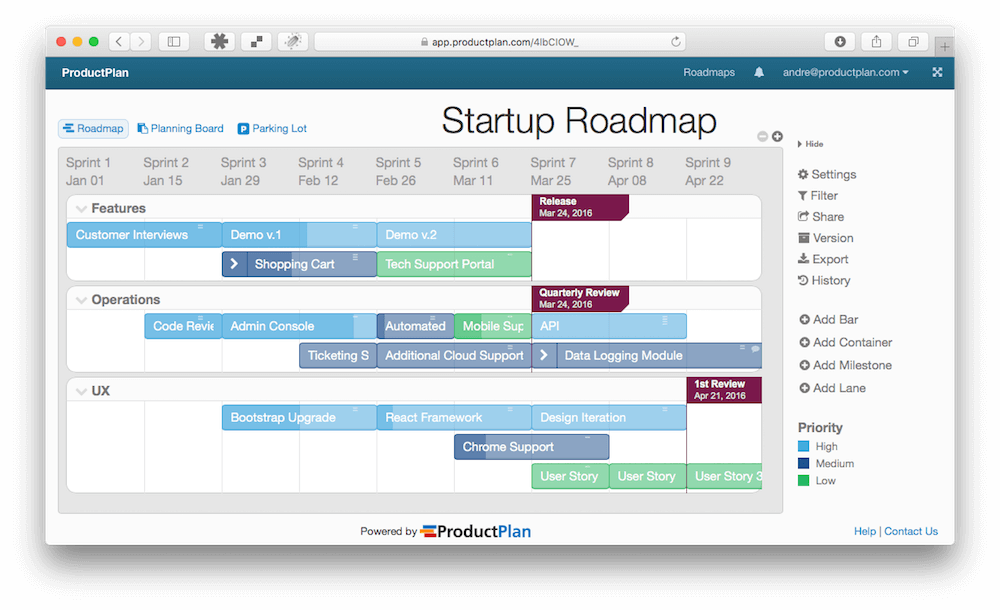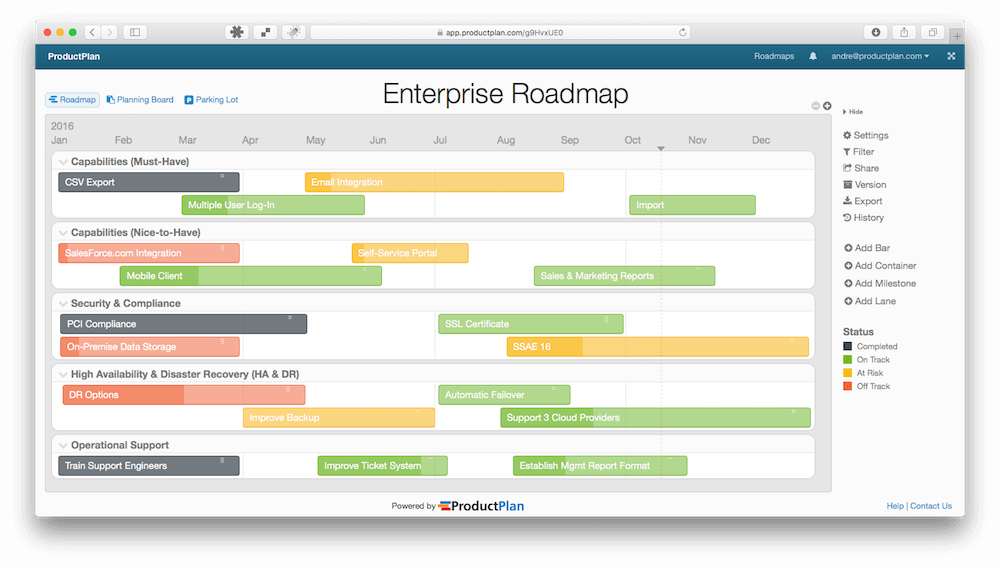Read the following product release schedule and determine whether it’s a smart and logical plan:
Release twice per month, with a minimum of three new features per release.
You can’t possibly answer, can you? You need a lot more information: the technology, the market, the user base, the company’s internal resources, the release schedules of the company’s competitors, etc. A product roadmap is not a one-size-fits-all strategic plan.
Tweet This:
“A product roadmap is not a one-size-fits-all strategic plan.”
Yes, we believe there are some basic, essential characteristics that all roadmaps should have in common to be successful. Product roadmaps should be high-level, visual, easy to present to any audience, and simple to update and share.
But many of those characteristics are a function of the tool you choose to develop your roadmap.
For a product manager just beginning to put together a roadmap for her product, there are even more fundamental questions to ask first, such as, “What should my roadmap include, focus on, and look like?” and “What is this roadmap supposed to do?”
There are no universal answers to those questions.
But one guide you can use in answering them — one of the most important pieces of information driving your product strategy and therefore your roadmap — is the current stage of your company.
The needs of a product roadmap for a startup will be very different from those of a large, established enterprise. Here are some thoughts about the fundamentals of product roadmaps for each of these types of companies.
Fundamentals for a Startup Roadmap
The original iPhone did not include cut, copy and paste capability.
A google search will uncover plenty of blog posts and articles from that era written by frustrated iPhone 1 users annoyed at the lack of such seemingly simple functionality. And you won’t find the tone of those articles changing to relief until years later, when Apple introduced cut, copy and paste for the iPhone with its release of iOS 3.
This decision offers a nice illustration of a key difference between the product roadmap for a startup and that of a more established company. At the startup phase, you will be focused on new, disruptive products and features, and your goal will be to get a minimum viable product to market as quickly as possible.
Now, you might be thinking, that Apple was by no means a startup when it launched the iPhone. That’s true — Apple was already a multibillion-dollar behemoth. But the iPhone team treated the project very much like a startup. Part of that involved making tough decisions — like trimming everything from the roadmap that wasn’t absolutely necessary to get their disruptive new product out the door.
Let’s look at a few of the components that will characterize a startup’s product roadmap and distinguish it from the roadmap of companies at more mature stages of life.
Startup Roadmap: What’s the Roadmap’s Timeframe?
 For several reasons, the time horizon of a product roadmap for a startup will generally be shorter than a roadmap for a larger and more mature company. In fact, oftentimes, roadmaps from a start-up company don’t even include dates but rather focus on the next few strategic initiatives that they need to focus on.
For several reasons, the time horizon of a product roadmap for a startup will generally be shorter than a roadmap for a larger and more mature company. In fact, oftentimes, roadmaps from a start-up company don’t even include dates but rather focus on the next few strategic initiatives that they need to focus on.
A startup will, in many cases, be looking to introduce something new and disruptive as quickly as possible — so that the company can start capturing attention, new users, and real-world feedback.
Keeping the roadmap short allows a startup to release sooner, gauge responses, identify problems, and adjust plans and priorities quickly.
Also, because they are often cash-strapped and backed by hurried investors, startups often feel the need to release their products more quickly to start generating revenue. For this reason, a startup product manager can rarely afford to include everything she’d like on her roadmap for the next release — her team won’t have the time to develop it all before they need to ship.
Startup Roadmap: What’s on it (and What’s Not)?
Another distinguishing feature of a startup roadmap is that it will often be weighted heavily in favor of new themes, ideas and features.
Whereas a more established company’s roadmap will include a mixture of new ideas and maintenance on the product for existing users, a startup roadmap is generally free to be more forward-looking and disruptive.
Plus, because a startup obviously will not have had its product out on the market for long (if at all), a startup roadmap will understandably require fewer development resources dedicated to fixes and other maintenance issues.
Startup Roadmap: What’s the Roadmap’s Goal?
A startup roadmap will also have some unique objectives.
For example, a new company will often find itself fighting for attention among the media, the analysts who cover its space, and its customer personas. For that reason, startups might release newer versions of their products more frequently, partly for the attention. Every time they introduce an upgrade to their product or a substantial new feature, for example, a startup has an opportunity to speak with the industry or business press and to their industry’s analysts.
Tweet This:
“Generally, startup roadmaps should be short-term and focus on biggest-bang-for-the-buck features.”
The roadmap for a startup, therefore, will often be focused on generating the greatest amount of interest for the product in the shortest timeframe possible. That generally means the roadmap will focus on the biggest bang-for-the-buck features — and leave everything else for a future release.
Roadmap Fundamentals for an Established Company
The product roadmap serves a substantially different purpose within a large, established business than it does for a young startup.
At an enterprise, the roadmap often reflects many competing agendas — and, indeed, managing these is one of the most difficult aspects of a large-company product manager’s role.
Often the roadmap will need to receive buy-in from stakeholders across multiple teams; it will place the product’s development in direct competition for resources against the company’s other projects. An enterprise product roadmap will need to balance the continual pressure for innovation with the equally important need to maintain and support the foundations of the product for its existing users. (The business-industry nickname for these large companies — “going concerns” — sounds about right.)
Enterprise: What’s the Roadmap’s Timeframe?

Larger companies tend to involve many more people, often across multiple departments, in the development of their products. This coordination takes time and requires synchronization across many teams. So these big enterprises generally plan farther out for their products and create roadmaps with longer timeframes — sometimes several years into the future.
And there’s another reason that enterprise roadmaps tend to have longer time horizons than the roadmaps of younger companies. A business whose product has been on the market for a longer time period — and therefore has a larger customer base — will inevitably have more maintenance issues associated with every roadmap. These issues might be reactive, such as bug fixes, or they might be proactive, such as ensuring the application works seamlessly with a new version of a complementary piece of software the customer often uses in conjunction.
Enterprise: What’s on the Roadmap (and What’s Not)?
Because a mature enterprise will have its products in the market, its product roadmap will look more well-rounded than that of a startup. Whereas the startup will be focused heavily on the innovation and disruption stage, the larger company will shift its focus to a balancing act between innovation and maintenance.
One way to think of this is that whereas a startup will be focused almost entirely on acquiring new customers, an established enterprise will dedicate some of its resources to capturing new users and some resources to continuing to support and satisfy its existing customers.
A large enterprise that simply focused on innovating — and neglected product maintenance completely — would quickly find itself in serious trouble with its user base.
Enterprise: What’s the Roadmap’s Goal?
Within an established company, the goal of a product roadmap is often to maintain the balancing act of any successful product. It needs to reflect the company’s ongoing efforts to solve new problems for the market and woo new customers while at the same time keeping the foundational underpinnings of the product intact and in as good shape as they were when the product first hit the market.
This can sometimes be the most challenging aspect of roadmapping for large-company product managers, who are often strategic thinkers continually generating and compiling exciting new ideas for their products.
Tweet This:
“Roadmapping challenge for enterprises: Balancing envelope-pushing initiatives with maintenance.”
Within a big company, the roadmap’s innovative and envelope-pushing initiatives almost always need to share the spotlight with the more mundane aspects of maintaining a successful product. But there is a major upside to embracing this reality. You’ll not only earn new customers with your great new ideas, but you’ll also continue generating happy existing customers with your maintenance work. And there aren’t many forms of advertising more powerful than happy customers.
Have you worked as a product manager for a startup or a large company? Tell us how you’ve dealt with product roadmaps in these types of businesses by leaving a comment.



